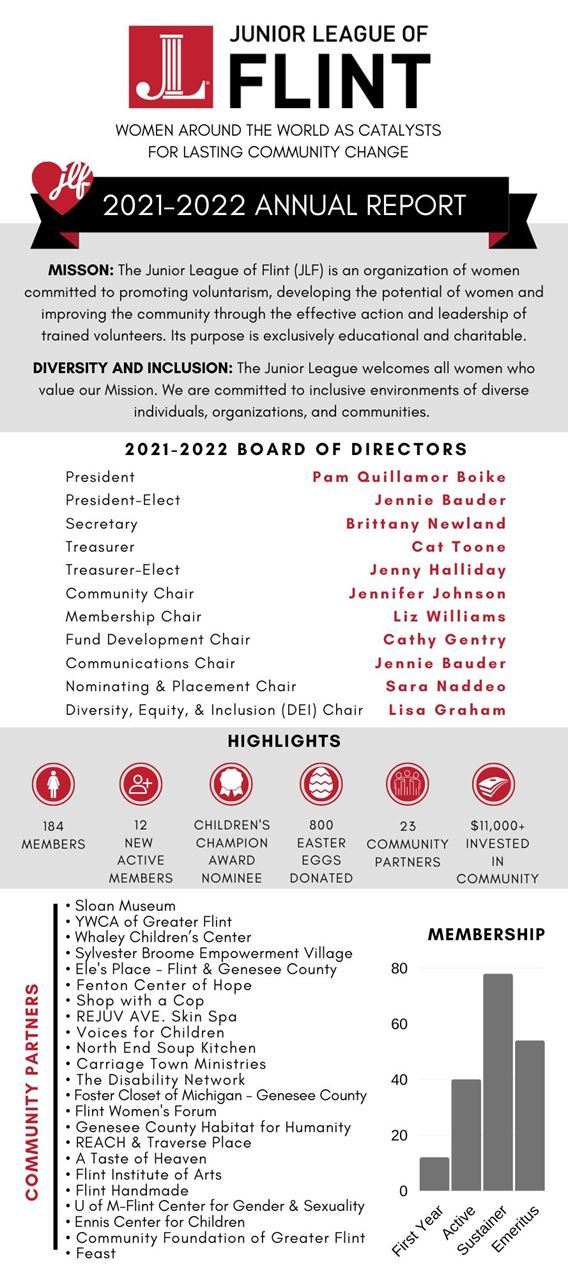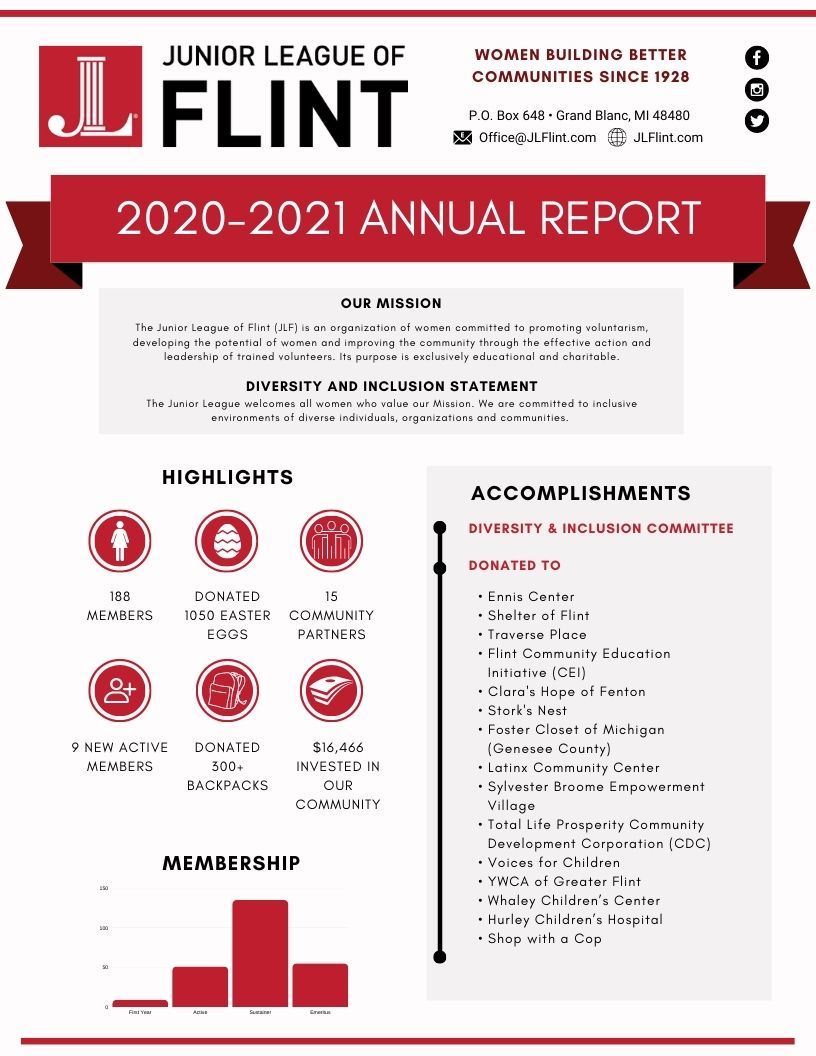| The History of the Junior League of FlintIn 1927, the Wednesday Club of Flint applied for membership in the Association of Junior Leagues of America. This group of 32 women was officially accepted as the Junior League of Flint, Michigan, Incorporated in March of 1928. From small group sewing for local charities, the organization has grown to over 350 Active, Sustaining and Provisional members who make a substantial contribution in the Flint area through volunteer service, financial assistance and community leadership. Through the years, the League has stressed training and education of its membership within the framework of the philosophy that self-development of a League member is meaningful only if it results in a tangible contribution to the world in which she lives. Thus, volunteer service has been the cornerstone of the program of the Flint League and of all other Junior Leagues. Through an individualized placement program which was formalized in 1931, League volunteers have at some time served almost every health and welfare agency in Flint. Service to the Red Cross was emphasized as part of the volunteer experience of every League member during the 1930s and 1940s. Other Red Cross assistance came in 1953 when a disastrous tornado leveled a section of Flint and League members staffed the Disaster Center for several weeks. Two major projects have reflected a determination to fill gaps in community services, to innovate and to demonstrate. The cerebral Palsy Nursery project from 1949 to 1955 successfully demonstrated a needed service that was carried on by the Board of Education. A senior Citizens project from 1957 to 1960 provided essential groundwork for many current community programs for older citizens. League establishment of a Volunteer Bureau (now named the Voluntary Action Center) as a department of the Council for Social Agencies in 1966 has expanded volunteer service opportunities for all citizens and has increased utilization of volunteer services by community organizations. A Homemaker Aid project, undertaken with the Family Service Agency in 1968 and continued by that agency, demonstrated the value of maintaining wholesome family living in times of stress. The Flint League entered the mental health field in 1962 with a grant for refurbishing the Mental Health Clinic and volunteer services for the Clinic. Work in this field continued from 1964 to 1967 when a Day Care Center for Emotionally Disturbed Children was established by the League. As a program of the Clinic, League members successfully worked directly with the children. In 1970, the League worked with Genesee County Community Mental Health Services to establish a Youth Listening Post which provided help for troubled teenagers. The visual and performing arts have been traditional fields for League service and leadership. League members produced children’s plays yearly from 1929 to 1969. In 1970, League member’s productions discontinued in light of changes in the whole field of children’s theater. The League has continued in children’s theater by helping to bring professional theater to the children of Flint. Puppet shows for schoolchildren were given from 1930 to 1942. Puppetry again became a League activity in 1954, and until 1967 League members trouped puppet shows to elementary schools and other special locations. League support for Flint Institute of Arts programs began with financial assistance in 1937 and has continued through the years in a variety of ways. An Art Institute docent program, initiated by the League, was expanded in 1962 with a financial contribution and is of continuing interest to League volunteers. In 1970, the League helped plan and support a Children’s Art Museum. League members began a similar docent service at the Sloan Museum of Transportation in 1969. A Young People’s Concert Project, undertaken with the Musical and Performing Arts Association in 1969 and 1970, brought concert experiences to the children of Flint. In the field of education, the League produced radio programs for children in 1948, 1952 and 1955. During 1968, in cooperation with the Flint Board of Education, the League initiated a community wide Volunteer-N-The-School program which supplemented and enriched their services of classroom teachers. A planned Change Program, initiated in 1970, brought a new internal structure to League operations. Out of this change, interest groups developed, designed to allow small groups of League members to pursue self-education, placement and projects within their field of interest. The Arts Interest Group continued and expanded the Leagues’ involvement in this field. They worked closely with the Flint Institute of Arts to insure the success of Art in Flint. In 1973, the group developed the project Art-to-the Schools in conjunction with the Flint Board of Education and the Flint Institute of Arts. Docents visited fifth grade classes with materials designed to develop an appreciation for visual art. Ballet master Milenko Banovitch, Flint’s Affiliate Artist sponsored by the League, performed and introduced the art of ballet to many areas of the community. Another Youth Concert was held in 1973 cosponsored with the Women’s Association of the Flint Institute of Music. In 1974, the Arts Interest Group cosponsored, with the Flint Board of Education and the Michigan Council for the Arts, an artist-in-residence. Syd Atkinson worked with junior and senior high school students in creating sculpture and fostering an understanding and appreciation of art. The flexibility inherent in interest groups has facilitated the entry of the League into some new areas of concern and interest. A Drug Interest Group was formed early in 1971 and had a significant effect on drug abuse education and rehabilitation in Flint. The League provided funds and administrative assistance to begin and sustain UP, INC., a drug drop-in center. The Genesee County Regional Drug Abuse Commission was strengthened through League participation on the Board and a drug counselor was provided by League funds. Feeling that their original objectives were met, the Drug Interest Group phased out in 1973, although members maintain their involvement in this field as individuals. The Ecology Interest Group provided a great deal of financial, administrative, and volunteer assistance to help the Flint Environmental Action Team (FEAT) become a coordinating unit for environmental concerns in Flint. Members of the interest group have developed an ecology program, including films and discussion, and taken it to elementary schools. In 1972-73 the Ecology Interest Group promoted recycling and raised money for the Community Trust Fund by selling recycled Christmas cards and stationary. The Interest Group phased out in 1974, though individual members continue to be active in FEAT. Leadership Flint, initiated by the Leadership Interest Group in 1972, provides the community with training of persons to assume positions of community decision making. A Grantmanship Interest Group was formed in 1973 to plan and carry out a seminar in grantmanship for League members and community participants. Members of the Learning Disabilities Interest Group developed the Bucket Brigade Project in 1973, in cooperation with the Flint Board of Education, to help children with reading problems. The League’s pilot project proved so successful that the Board of Education continued with it beyond 1975, when the League funding and participation phased out. 1974-75 was a year of economic stress and the United Way suffered greatly from layoffs. Feeling our financial responsibility and concern for the many United Way agencies which began as a result of Junior League projects we donated $2,000 to help them out of their financial crisis. Two interest groups began in 1975-76 as a result of the Bicentennial, both culminating in projects. The Crossroads Village Interest Group researched, furnished and wrote a docent program for the Buzzell House located in the Genesee Recreation Area. A coalition of community persons and organizations active in theater formed the Flint Historical Theatre, Inc. for the purpose of writing and producing a play depicting Flint’s history. The Aging Interest Group, which began with the Evening Actives in 1975, culminated in the establishment of a Day Care Facility in 1976. After three years of exploration, research and training the Everywoman’s Center was opened in January 1976. In Information and Referral component of the EWC was funded by the League. 1976-177 was a year in which $19,000 of the Community Trust Fund were returned to our community. Many of the projects, such as the Everywoman’s Center, the Geriatric Daycare Center, Flint Historical Theatre (whose Bi-Centennial play was produced in April 1977), and Buzzell House were continuations from the previous year. New projects included a grant for the Riverfront beautification and in the inception of two Task Forces: Youth Volunteers and Against Pornography Involving Children. These compared admirably with our General Focus Area for the year which was Child Advocacy. The 1970’s brought increased emphasis on training and education of League members. The Association offered opportunities for learning and teaching skills such as: Management by Objectives or AMP, Career Development or Life Planning, and child Advocacy. 1977-78 was a year both to reflect and to look to the future by celebrating the 50th anniversary of the Junior League of Flint. For the first time the Junior League actively sought community and state board positions in order to be decision-makers in our special areas of interest. Advocacy became a part of the League vocabulary and part of our structure. The Junior League’s purpose for raising funds is to be able to return these funds to the community. In addition to our historically successful fundraiser, Town Hall, other new fundraising concepts were introduced in the 1980s, all proving to be financially profitable. The League operated its first Decorator Show House in 1980. The first Great Gatsby Party was held in 1984. In 1986, the League planned and hosted its first holiday mart, Merry Marketplace. The success of these major fundraisers, in addition to cookbook sales and Road Rally profits have insured that our League may continue to respond to community needs as a funding organization. In the 1980s, the League continued its campaign of community awareness and response to community needs. The creation of an Enabling Fund gave us greater flexibility on meeting these needs. It also helped raise the awareness of who we were and what we were about. Coalition building continues to be the area for increased impact. The membership of the Junior League of Flint has changed dramatically since 1927. Women are facing changing lifestyles, with 60% of our members now employed outside of the home. These and other factors greatly contribute to today’s League member’s of lack of discretionary time. Projects providing quality placement as well as meeting the needs of the membership become increasingly important. Often the solutions to these directives are not the same. Thus the challenge of the future. |




